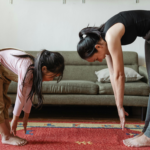In the fast-paced world we live in, one of the most common barriers to fitness is simply fitting it in. Many people know they should move more, stretch regularly, or build strength—but struggle to make it stick. That’s where habit stacking comes in.
Grounded in behavioral science, habit stacking is a technique that helps you anchor a new habit (like exercise) to an existing one. The result? Fitness becomes part of your day without requiring extra motivation or planning.
This article explores how habit stacking works and how you can use it to build a consistent, sustainable fitness routine—even if you’re short on time.
What Is Habit Stacking?
The term comes from James Clear, author of Atomic Habits, and is rooted in the psychology of habit formation. The idea is simple: instead of trying to create a new habit from scratch, you stack it onto something you already do every day.
For example:
- After I brush my teeth, I will do 10 bodyweight squats.
- After I make my morning coffee, I will stretch for 2 minutes.
- After my last work call of the day, I will take a 10-minute walk.
By pairing fitness with established routines, it becomes easier to remember and harder to skip.
Why Habit Stacking Works
Habit stacking leverages the brain’s natural tendency to follow routines and reduces the mental load of decision-making. It:
- Removes the need for willpower
- Anchors exercise to consistent cues in your day
- Encourages micro-habits that can grow over time
- Builds consistency through simplicity
And because the fitness activities are short and manageable, you’re more likely to follow through even on your busiest days.
How to Start Habit Stacking for Fitness
Step 1: Identify Current Habits
Start by listing activities you already do daily, such as:
- Brushing your teeth
- Making coffee
- Taking a shower
- Checking emails
- Walking the dog
- Finishing a meeting
- Turning on the TV in the evening
These are your anchors. The more specific and consistent, the better.
Step 2: Choose a Simple Fitness Habit
Pick an action that:
- Takes less than 5 minutes to start
- Requires minimal equipment or setup
- Matches the energy level of the anchor habit
Examples:
- 10 push-ups after making your bed
- Calf raises while brushing your teeth
- A 30-second plank after logging off work
- 3 yoga stretches after unloading the dishwasher
- A short walk around the block before dinner
Start small—you can always scale up later.
Step 3: Use Clear Habit Formulas
Use this formula to create your stack:
“After [current habit], I will [new habit].”
Some effective combinations:
- After I brew my coffee, I will do 15 bodyweight squats.
- After I take off my shoes at home, I will foam roll for 2 minutes.
- After I finish breakfast, I will take a 10-minute walk.
Keep it simple and repeatable.
The Compound Effect of Micro Workouts
What makes habit stacking so powerful is the accumulation of effort. While a 3-minute stretch or 10 squats may seem insignificant, doing it daily builds consistency, muscle memory, and confidence.
Over weeks and months, these mini-sessions:
- Improve mobility and strength
- Increase overall activity levels
- Reduce sedentary time
- Create momentum for bigger workouts
And once the micro habit is embedded, you’re more likely to expand on it—turning 10 squats into 20, or a walk into a jog.
Habit Stacking for Different Fitness Goals
For Strength:
- Do a set of push-ups, lunges, or squats after routine tasks.
- Keep a resistance band near your desk and use it after video calls.
For Flexibility:
- Stretch for 2–3 minutes after meals or during TV commercials.
- Do a yoga pose after brushing your teeth or taking a shower.
For Cardio:
- Walk during work calls or while listening to a podcast.
- Climb stairs after checking your phone.
For Core Stability:
- Hold a plank every morning after making your bed.
- Do 10 leg raises after each bathroom break.
Tips for Long-Term Success
- Keep it visible: Leave a mat, dumbbell, or foam roller in sight as a visual cue.
- Pair it with a reward: Follow your fitness habit with something pleasant—like tea or music.
- Track your consistency: Use a habit tracker or calendar to reinforce the streak.
- Adjust as needed: If a stack stops working, revise the pairing—not the goal.
- Be flexible: Life will interrupt routines—what matters is returning to your habit as soon as possible.
Final Thoughts
You don’t need a full gym session or perfect schedule to make fitness a regular part of your life. With habit stacking, you tap into your existing routines and create a low-effort path to daily movement.
Whether your goal is better mobility, more energy, or simply getting started, small, consistent actions will take you further than occasional, intense efforts. Build habits where they already belong—in your everyday life—and your fitness will become automatic.



